NCERT Solutions | Class 11 Chemistry Chapter 7 | Equilibrium

CBSE Solutions | Chemistry Class 11
Check the below NCERT Solutions for Class 11 Chemistry Chapter 7 Equilibrium Pdf free download. NCERT Solutions Class 11 Chemistry were prepared based on the latest exam pattern. We have Provided Equilibrium Class 11 Chemistry NCERT Solutions to help students understand the concept very well.
NCERT | Class 11 Chemistry
| Book: | National Council of Educational Research and Training (NCERT) |
|---|---|
| Board: | Central Board of Secondary Education (CBSE) |
| Class: | 11th |
| Subject: | Chemistry |
| Chapter: | 7 |
| Chapters Name: | Equilibrium |
| Medium: | English |
Equilibrium | Class 11 Chemistry | NCERT Books Solutions
NCERT Exercises
NCERT Solutions for Class 11 Chemistry Chapter 7, Question 1.
volume of the container is suddenly increased.
(a) What is the initial effect of the change on vapour pressure?
(b) How do rates of evaporation and condensation change initially?
(c) What happens when equilibrium is restored finally and what will be the final vapour pressure?
Solution.
(a) Vapour pressure decreases since equilibrium is disturbed and the rate of condensation falls considerably.(b) Rate of evaporation increases while that of condensation falls initially.
(c) On restoration of the equilibrium again, the vapour pressure becomes the same.
NCERT Solutions for Class 11 Chemistry Chapter 7, Question 2.
2SO2(g) + O2(g) ⇌ 2SO3(g)
Solution.
2SO2(g) + O2(g) ⇌ 2SO3(g)Applying law of chemical equilibrium,
\({ K }_{ c }=\frac { { \left[ { SO }_{ 3 } \right] }^{ 2 } }{ { \left[ { SO }_{ 2 } \right] }^{ 2 }\left[ { O }_{ 2 } \right] } =\frac { { (1.9) }^{ 2 } }{ { (0.6) }^{ 2 }{ (0.82) } } =12.229L\quad { mol }^{ -1 } \)
NCERT Solutions for Class 11 Chemistry Chapter 7, Question 3.
Solution.

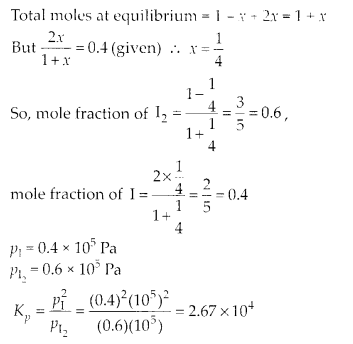
NCERT Solutions for Class 11 Chemistry Chapter 7, Question 4.
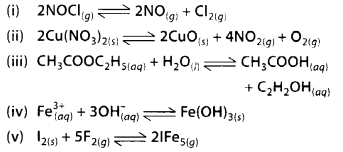
Solution.
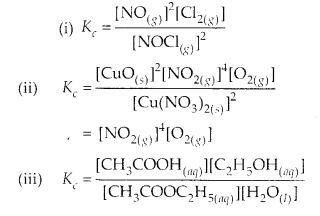
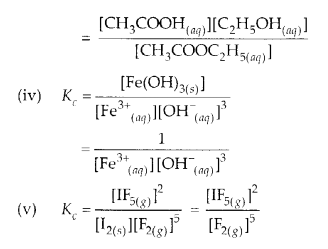
NCERT Solutions for Class 11 Chemistry Chapter 7, Question 5.

Solution.

NCERT Solutions for Class 11 Chemistry Chapter 7, Question 6.
Solution.
NO(g) + O3(g) ⇌ NO2(g) + O2(g)\({ K }_{ c }=\frac { \left[ { NO }_{ 2 } \right] \left[ { O }_{ 2 } \right] }{ \left[ NO \right] \left[ { O }_{ 3 } \right] } =6.3\times { 10 }^{ 14 }\)
For the reverse reaction,
\({ K }_{ c }^{ ` }=\frac { \left[ NO \right] \left[ { O }_{ 3 } \right] }{ \left[ { NO }_{ 2 } \right] \left[ { O }_{ 2 } \right] } =\frac { 1 }{ { K }_{ c } } =\frac { 1 }{ 6.3\times { 10 }^{ 14 } } =1.587\times { 10 }^{ -15 }\)
NCERT Solutions for Class 11 Chemistry Chapter 7, Question 7.
Solution.
For the concentration of pure solid or pure liquid,\(Molar\quad conc.=\frac { Moles\quad of\quad the\quad substance }{ Volume\quad of\quad the\quad substance } \)
\(=\frac { Mass/Molar\quad mass }{ Volume } =\frac { Mass }{ Volume } \times \frac { 1 }{ Molar\quad mass } =\frac { Density }{ Molecular\quad mass } \)
Since density of pure solid or liquid is constant at constant temperature and molar mass is also constant therefore, their molar concentrations are constant and are included in the equilibrium constant.
NCERT Solutions for Class 11 Chemistry Chapter 7, Question 8.
2N2(g) + O2(g) ⇌ 2N2O(g)
If a mixture of 0.482 mol of N2 and 0.933 mol of O2 is placed in a 10 L reaction vessel and allowed to form N2O at a temperature for which Kc = 2.0 x 10-37, determine the composition of equilibrium mixture.
Solution.
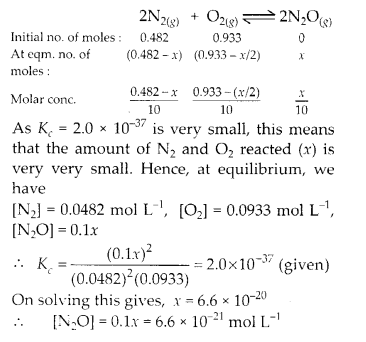
NCERT Solutions for Class 11 Chemistry Chapter 7, Question 9.
2NO(g) + Br2(g) ⇌ 2NOBr(g) When 0.087 mol of NO and 0.0437 mol of Br2 are mixed in a closed container at constant temperature, 0.0518 mol of NOBr is obtained at equilibrium. Calculate equilibrium amount of NO and Br2.
Solution.
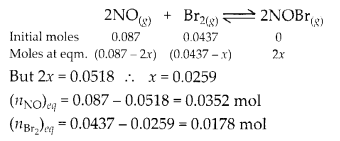
NCERT Solutions for Class 11 Chemistry Chapter 7, Question 10.
2SO2(g)+ O2(g) ⇌ 2SO3(g)
What is Kc at this temperature?
Solution.
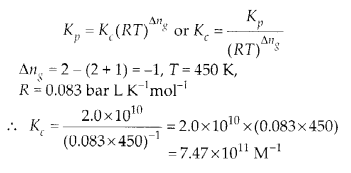
NCERT Solutions for Class 11 Chemistry Chapter 7, Question 11.
2HI(g) \(\rightleftharpoons \) H2(g) + I2(g)
Solution.
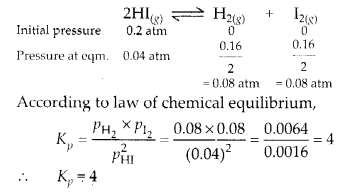
NCERT Solutions for Class 11 Chemistry Chapter 7, Question 12..
N2(g) + 3H2(g) \(\rightleftharpoons \) 2NH3(g) is 1.7 × 10-2.
Is this reaction at equilibrium ? If not, what is the direction of net reaction ?
Solution.
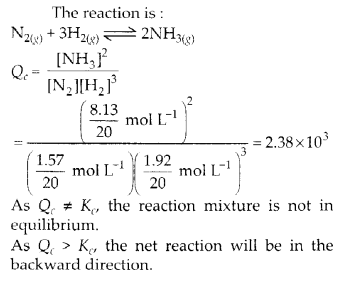
NCERT Solutions for Class 11 Chemistry Chapter 7, Question 13.

Write the balanced chemical equation corresponding to this expression.
Solution.
Balanced chemical equation for the reaction is4 NO(g) + 6 H2O(g) \(\rightleftharpoons \) 4NH3(g) + 5 O2(g)
NCERT Solutions for Class 11 Chemistry Chapter 7, Question 14.
H2O(g) + CO(g) \(\rightleftharpoons \) H2(g) + CO2(g)
Calculate the equilibrium constant for the reaction.
Solution.
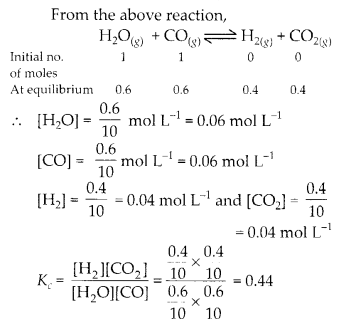
NCERT Solutions for Class 11 Chemistry Chapter 7, Question 15.
Solution.
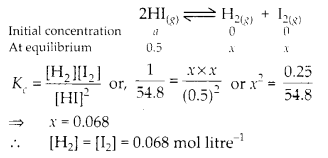
NCERT Solutions for Class 11 Chemistry Chapter 7, Question 16.
2ICl(g) \(\rightleftharpoons \) I2(g) + Cl2(g) ; Kc = 0.14
Solution.
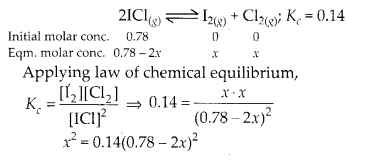
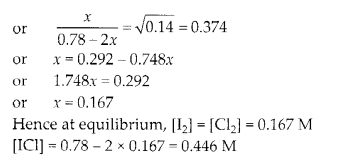
NCERT Solutions for Class 11 Chemistry Chapter 7, Question 17.
C2H6(g) \(\rightleftharpoons \) C2H4(g) + H2(g)
Solution.
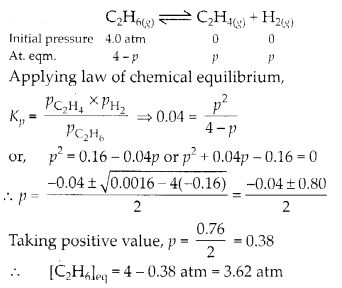
NCERT Solutions for Class 11 Chemistry Chapter 7, Question 18.
CH3COOHl + C2H5OHl \(\rightleftharpoons \) CH3COOC2H5l + H2Ol
(i) Write the concentration ratio (concentration quotient) Q for this reaction. Note that water is not in excess and is not a solvent in this reaction.
(ii) At 293 K, if one starts with 1.000 mol of acetic acid and 0.180 mol of ethanol, there is 0.171 mol of ethyl acetate in the final equilibrium mixture. Calculate the equilibrium constant.
(iii) Starting with 0.50 mol of ethanol and 1.000 mol of acetic acid and maintaining it at 293 K, 0.214 mol of ethyl acetate
is found after some time. Has equilibrium been reached ?
Solution.

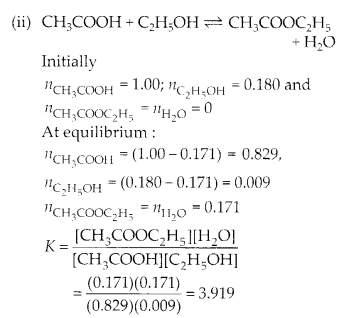
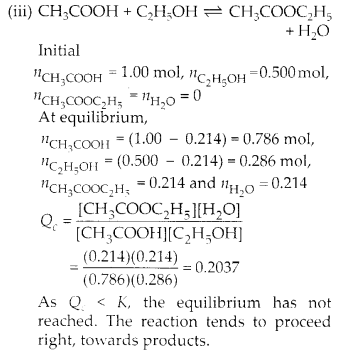
NCERT Solutions for Class 11 Chemistry Chapter 7, Question 19.
Solution.
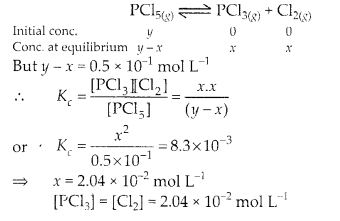
NCERT Solutions for Class 11 Chemistry Chapter 7, Question 20.
FeO(s) + CO(g) \(\rightleftharpoons \) Fe(s) + CO2(g); Kp = 0.265 atm at 1050 K
What are the equilibrium partial pressures of CO and CO2 at 1050 K if the initial pressures are :Pco = 1.4 atm and Pco2 = 0.80 atm ?
Solution.
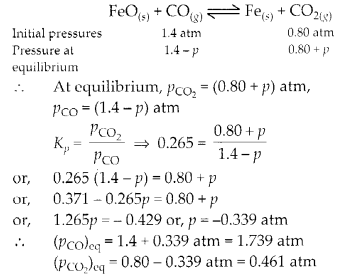
NCERT Solutions for Class 11 Chemistry Chapter 7, Question 21.
Solution.
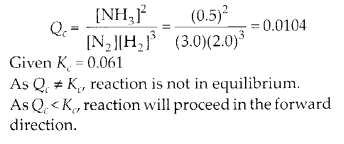
NCERT Solutions for Class 11 Chemistry Chapter 7, Question 22.
2BrCl(g) \(\rightleftharpoons \) Br2(g) + Cl2(g)
For which Kc is 32 at 500 K. If initially pure BrCl is present at a concentration of 3.3× 10-3 mol L-1, what is its molar concentration in the mixture at equilibrium ?
Solution.

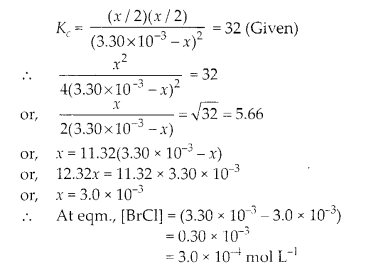
NCERT Solutions for Class 11 Chemistry Chapter 7, Question 23.
C(s) + CO2(g) \(\rightleftharpoons \) 2CO(g)
Calculate Kc for the reaction at the above temperature.
Solution.
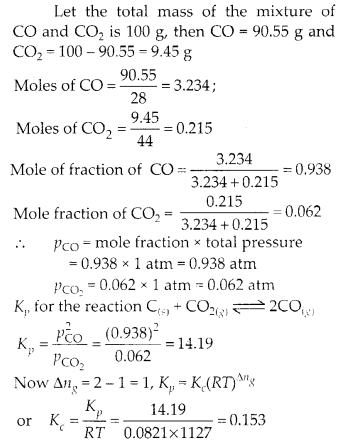
NCERT Solutions for Class 11 Chemistry Chapter 7, Question 24.
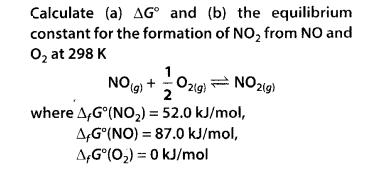
Solution.
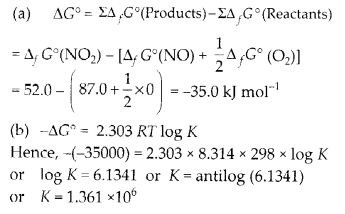
NCERT Solutions for Class 11 Chemistry Chapter 7, Question 25.
(a) PCl5(g) \(\rightleftharpoons \) PCl3(g) + Cl2
(b) CaO(s) + CO2(g) \(\rightleftharpoons \) CaCO3(s)
(c) 3Fe(s) + 4H2O(g) \(\rightleftharpoons \) Fe3O4(s) + 4H2(g)
Solution.
Applying Le Chatelier’s principle, on decreasing the pressure, equilibrium shifts to the direction in which pressure increases, i.e., number of moles of gaseous substances is more. Thus, moles of reaction products will increase in reaction (a), decrease in reaction (b) and remain same (np, = nr gaseous) in reaction (c).NCERT Solutions for Class 11 Chemistry Chapter 7, Question 26.
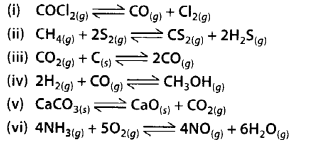
Solution.
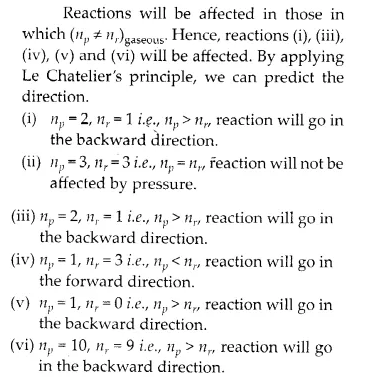
NCERT Solutions for Class 11 Chemistry Chapter 7, Question 27.
H2(g) + Br2(g) \(\rightleftharpoons \) 2HBr(g)
Find the equilibrium pressure of all gases if 10.0 bar of HBr is introduced into a sealed container at 1024K.
Solution.
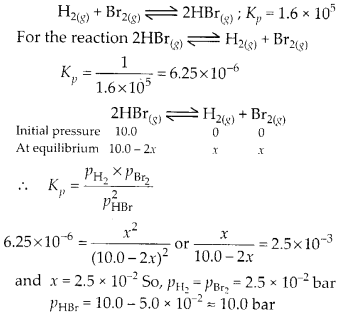
NCERT Solutions for Class 11 Chemistry Chapter 7, Question 28.
CH4(g) + H2O(g) \(\rightleftharpoons \) CO(g) + 3H2(g)
(a) Write the expression for Kp for the above reaction
(b) How will the value of Kp and composition of equilibrium mixture be affected by :
(i) increasing the pressure
(ii) increasing the temperature
(iii) using a catalyst ?
Solution.

(b)
- By Le Chatelier’s principle, on increasing pressure, equilibrium will shift in the backward direction where number of moles decreases.
- As the given reaction is endothermic, by Le Chatelier ‘sprinciple, equilibrium will shift in the forward direction with increasing temperature.
- Equilibrium composition will not be disturbed by the presence of catalyst but equilibrium will be attained quickly.
NCERT Solutions for Class 11 Chemistry Chapter 7, Question 29.
(a) addition of H2
(b) addition of CH3OH
(c) removal of CO
(d) removal of CH3OH on the equilibrium of the reaction:
2H2(g) + CO(g) \(\rightleftharpoons \) CH3OH ?
Solution.
2H2(g) + CO(g) \(\rightleftharpoons \) CH3OH Effect of(a) addition of H2 : The equilibrium will shift in the forward direction.
(b) addition of CH3OH : The equilibrium will shift in the backward direction.
(c) removal of CO : The equilibrium will shift in the backward direction.
(d) removal of CH3OH : The equilibrium will shift in the forward direction.
NCERT Solutions for Class 11 Chemistry Chapter 7, Question 30.
PCl5(g) \(\rightleftharpoons \) PCl3(g) + Cl2(g) ; ∆H = + 124.0 kJ mol-1
(a) Write an expression for Kc for the reaction.
(b) What is the value of Kc for the reverse reaction at the same temperature ?
What would be the effect on Kc if
(i) more PCl5 is added
(ii) pressure is increased
(iii) the temperature is increased?
Solution.
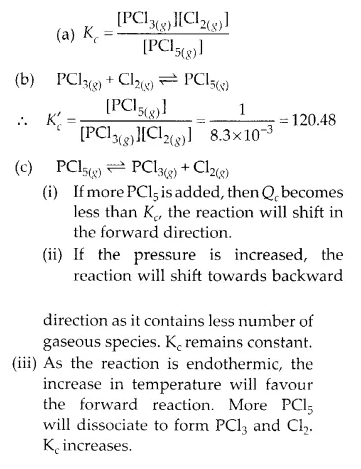
NCERT Solutions for Class 11 Chemistry Chapter 7, Question 31.
CO(g) + H2O(g) \(\rightleftharpoons \) CO2(g) + H2(g)
If a reaction vessel at 400°C is charged with an equimolar mixture of CO and steam so that pco = PH2O = 4.0 bar, what will be the partial pressure of H2 at equilibrium ? Kp = 0.1 at 400°C.
Solution.
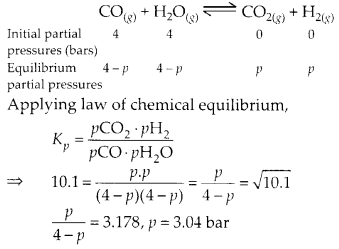
NCERT Solutions for Class 11 Chemistry Chapter 7, Question 32.
(a) Cl2(g) \(\rightleftharpoons \) 2Cl(g) ; Kc = 5 ×10-39
(b) Cl2(g) + 2NO(g) \(\rightleftharpoons \) 2NOCl(g) ; Kc = 3.7 × 108
(c) Cl2(g) + 2NO2 (g) \(\rightleftharpoons \) 2NO2Cl(g) ; Kc = 1.8.
Solution.
(a) Since the value of Kc is very small∴ There will be appreciable concentration of the reactants.
(b) Since Kc is very large.
∴ There will be appreciable concentration of the products.
(c) Since Kc = 1.8, the concentration of reactants and products will be in comparable amounts.
NCERT Solutions for Class 11 Chemistry Chapter 7, Question 33.
Solution.
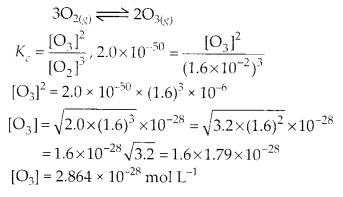
NCERT Solutions for Class 11 Chemistry Chapter 7, Question 34.
Solution.
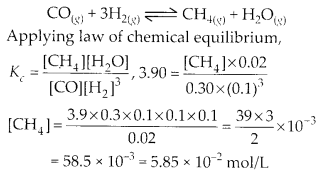
NCERT Solutions for Class 11 Chemistry Chapter 7, Question 35.
HNO2,CN–,HClO4,OH–,CO32-,S2-.
Solution.
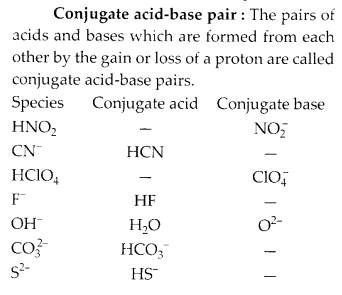
NCERT Solutions for Class 11 Chemistry Chapter 7, Question 36.
H2O, BF3, H+ and NH4+
Solution.
BF3, H+ and NH4+ are Lewis acids because they can accept a lone pair of electrons.NCERT Solutions for Class 11 Chemistry Chapter 7, Question 37.
Solution.

NCERT Solutions for Class 11 Chemistry Chapter 7, Question 38.
\({ NH }_{ 2 }^{ – }\), NH3 and HCOO–
Solution.

NCERT Solutions for Class 11 Chemistry Chapter 7, Question 39.
Solution.
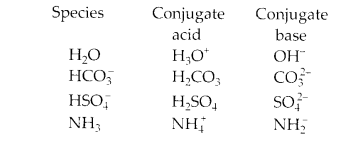
NCERT Solutions for Class 11 Chemistry Chapter 7, Question 40.
(a) OH–
(b) F–
(c) H+
(d) BCl3
Solution.
(a) OH– : OH– is a Lewis base because it can donate lone pair of electrons.(b) F– : F– is a Lewis base because it can donate lone pair of electrons.
(c) H+ : H+is a Lewis acid because it can accept lone pair of electrons.
(d) BCl3 : is a Lewis acid because it is electron deficient and can accept a lone pair of electrons.
NCERT Solutions for Class 11 Chemistry Chapter 7, Question 41.
Solution.
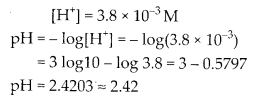
NCERT Solutions for Class 11 Chemistry Chapter 7, Question 42.
Solution.

NCERT Solutions for Class 11 Chemistry Chapter 7, Question 43.
Solution.
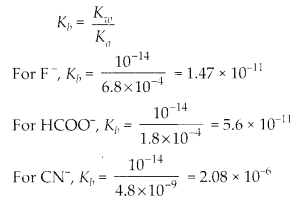
NCERT Solutions for Class 11 Chemistry Chapter 7, Question 44.
Solution.
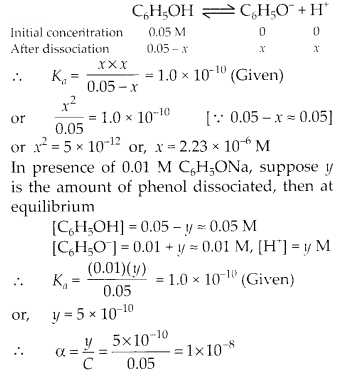
NCERT Solutions for Class 11 Chemistry Chapter 7, Question 45.
Solution.
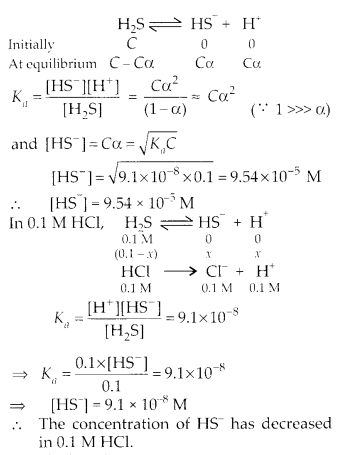
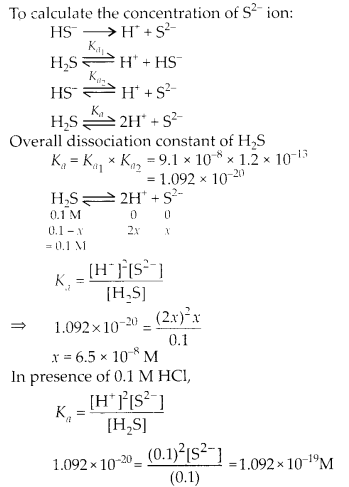
NCERT Solutions for Class 11 Chemistry Chapter 7, Question 46.
Solution.
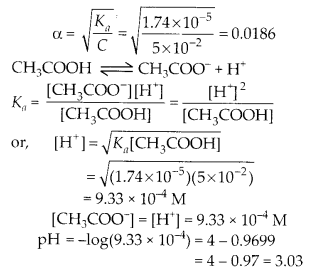
NCERT Solutions for Class 11 Chemistry Chapter 7, Question 47.
Solution.
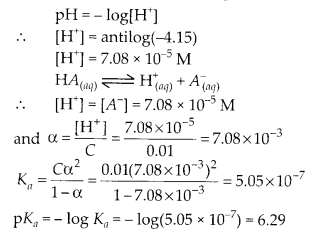
NCERT Solutions for Class 11 Chemistry Chapter 7, Question 48.
(a) 0.003 M HCl
(b) 0.005 M NaOH
(c) 0.002 M HBr
(d) 0.002 M KOH.
Solution.
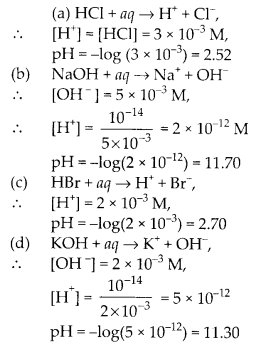
NCERT Solutions for Class 11 Chemistry Chapter 7, Question 49.
(a) 2 g of TIOH dissolved in water to give 2 litre of solution.
(b) 0.3 g of Ca(OH)2 dissolved in water to give 500 mL of solution.
(c) 0.3 g of NaOH dissolved in water to give 200 mL of solution.
(d) 1 mL of 13.6 M HCl diluted with water to give 1 litre of solution.
Solution.
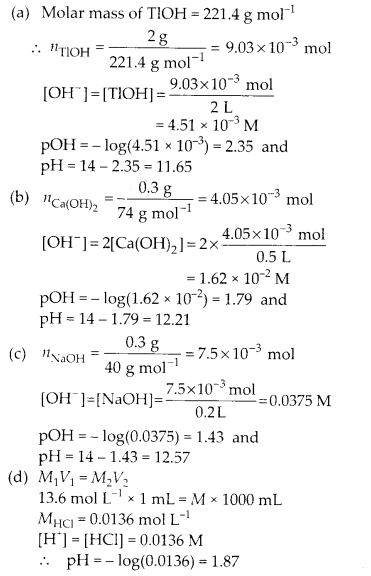
NCERT Solutions for Class 11 Chemistry Chapter 7, Question 50.
Solution.
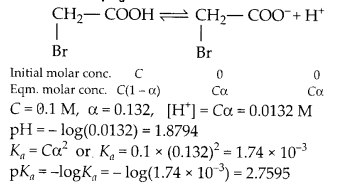
NCERT Solutions for Class 11 Chemistry Chapter 7, Question 51.
Solution.
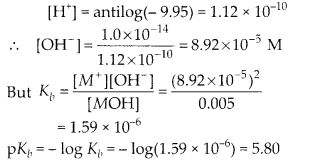
NCERT Solutions for Class 11 Chemistry Chapter 7, Question 52.
Solution.
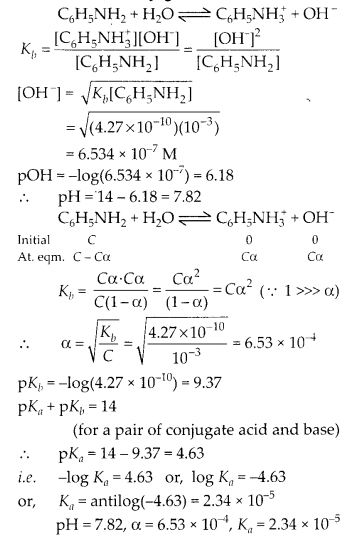
NCERT Solutions for Class 11 Chemistry Chapter 7, Question 53.
Solution.

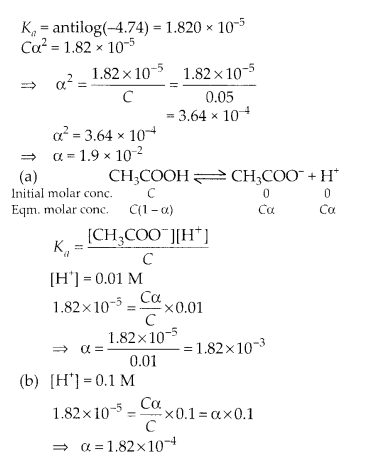
NCERT Solutions for Class 11 Chemistry Chapter 7, Question 54.
Solution.
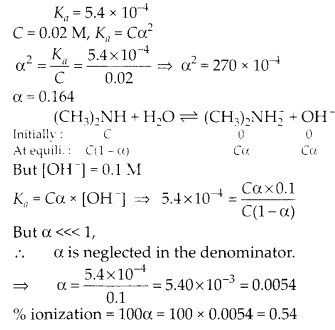
NCERT Solutions for Class 11 Chemistry Chapter 7, Question 55.
(a) Human muscles fluid 6.83
(b) Human stomach fluid 1.2.
(c) Human blood 7.38
(d) Human saliva 6.4
Solution.
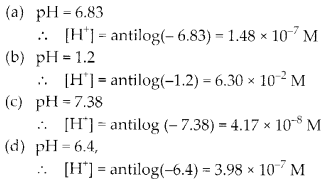
NCERT Solutions for Class 11 Chemistry Chapter 7, Question 56.
Solution.
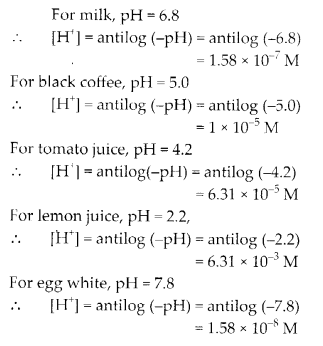
NCERT Solutions for Class 11 Chemistry Chapter 7, Question 57.
Solution.
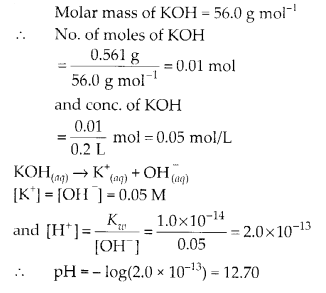
NCERT Solutions for Class 11 Chemistry Chapter 7, Question 58.
Solution.
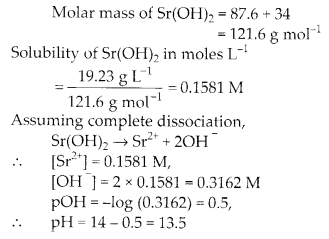
NCERT Solutions for Class 11 Chemistry Chapter 7, Question 59.
Solution.
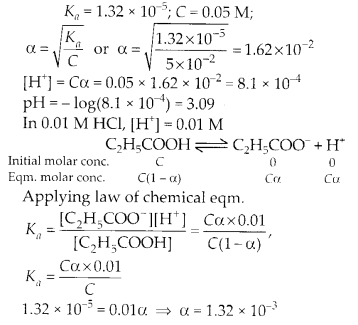
NCERT Solutions for Class 11 Chemistry Chapter 7, Question 60.
Solution.
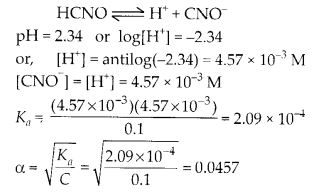
NCERT Solutions for Class 11 Chemistry Chapter 7, Question 61.
Solution.
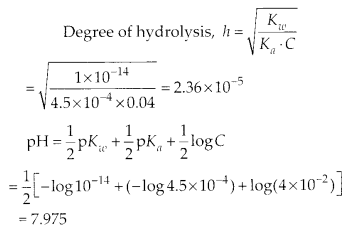
NCERT Solutions for Class 11 Chemistry Chapter 7, Question 62.
Solution.
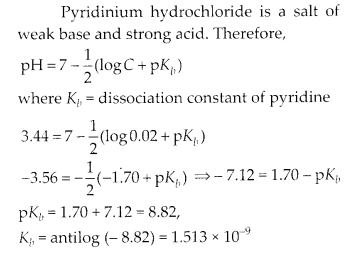
NCERT Solutions for Class 11 Chemistry Chapter 7, Question 63.
NaCl, KBr, NaCN, NH4NO3, NaNO2, and KF
Solution.
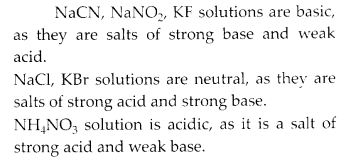
NCERT Solutions for Class 11 Chemistry Chapter 7, Question 64.
Solution.
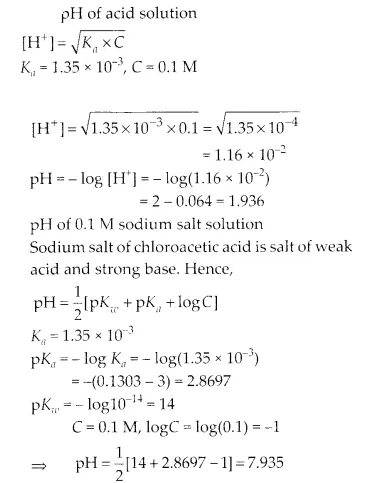
NCERT Solutions for Class 11 Chemistry Chapter 7, Question 65.
Solution.

NCERT Solutions for Class 11 Chemistry Chapter 7, Question 66.
(a) 10 mL. of 0.2 M Ca(OH)2 + 25 mL of 0.1 M HCl
(b) 10 mL of 0.01 M H2SO4 + 10 mL of 0.01 M Ca(OH)2
(c) 10 mL of 0.1 M H2SO4 + 10 mL of 0.1 M KOH.
Solution.
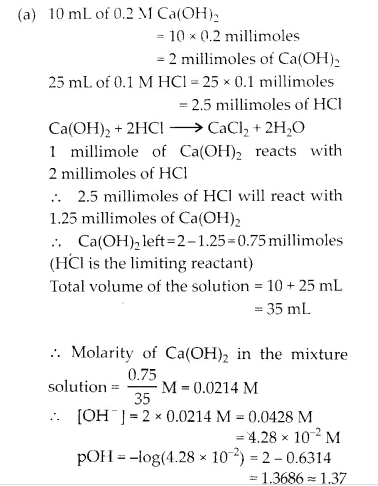
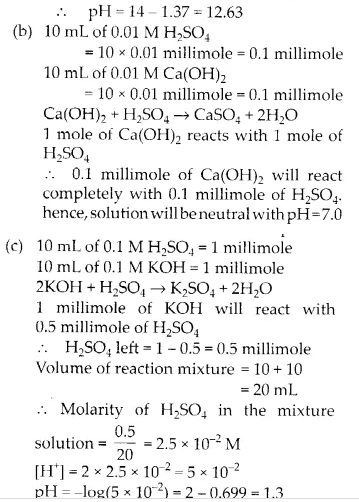
NCERT Solutions for Class 11 Chemistry Chapter 7, Question 67.
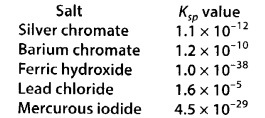
Solution.
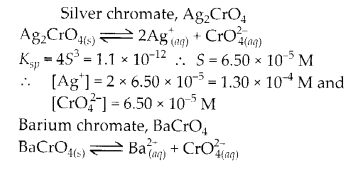
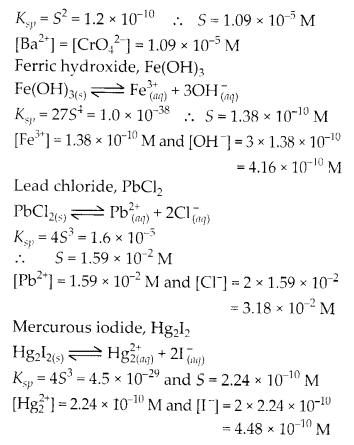
NCERT Solutions for Class 11 Chemistry Chapter 7, Question 68.
Solution.
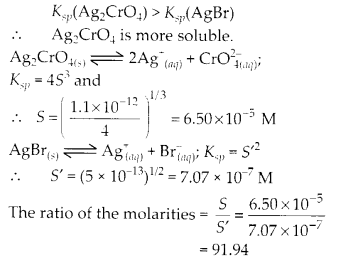
NCERT Solutions for Class 11 Chemistry Chapter 7, Question 69.
Solution.
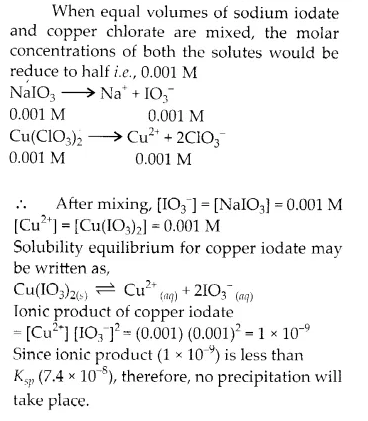
NCERT Solutions for Class 11 Chemistry Chapter 7, Question 70.
Solution.
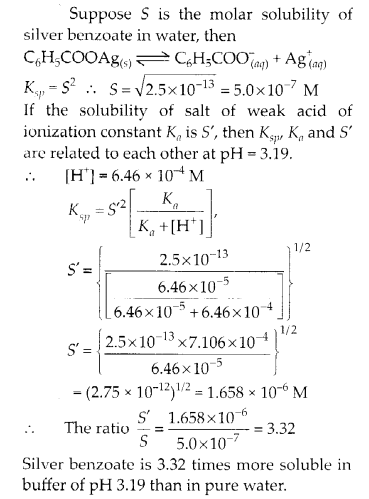
NCERT Solutions for Class 11 Chemistry Chapter 7, Question 71.
Solution.
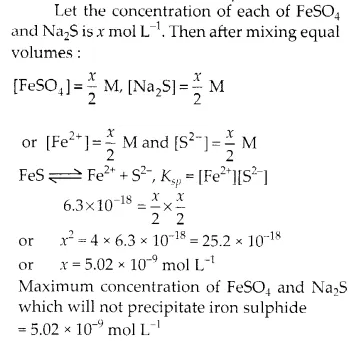
NCERT Solutions for Class 11 Chemistry Chapter 7, Question 72.
Solution.
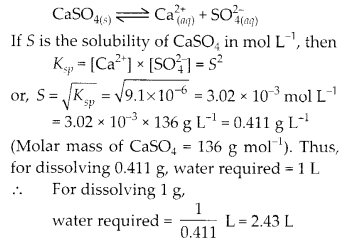
NCERT Solutions for Class 11 Chemistry Chapter 7, Question 73.
Given Ksp for
FeS = 6.3 × 10-18,
MnS = 2.5 × 10-13,
ZnS = 1.6 × 10-24 and
CdS = 8.0 × 10-27.
Solution.
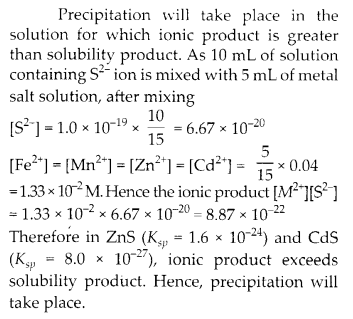
NCERT Class 11 Chemistry
Class 11 Chemistry Chapters | Chemistry Class 11 Chapter 7
Chapterwise NCERT Solutions for Class 11 Chemistry
-
NCERT Solutions For Class 11 Chemistry Chapter 1 Some Basic Concepts of Chemistry
NCERT Solutions For Class 11 Chemistry Chapter 2 Structure of The Atom
NCERT Solutions For Class 11 Chemistry Chapter 3 Classification of Elements and Periodicity in Properties
NCERT Solutions For Class 11 Chemistry Chapter 4 Chemical Bonding and Molecular Structure
NCERT Solutions For Class 11 Chemistry Chapter 5 States of Matter
NCERT Solutions For Class 11 Chemistry Chapter 6 Thermodynamics
NCERT Solutions For Class 11 Chemistry Chapter 7 Equilibrium
NCERT Solutions For Class 11 Chemistry Chapter 8 Redox Reactions
NCERT Solutions For Class 11 Chemistry Chapter 9 Hydrogen
NCERT Solutions For Class 11 Chemistry Chapter 10 The sBlock Elements
NCERT Solutions For Class 11 Chemistry Chapter 11 The pBlock Elements
NCERT Solutions For Class 11 Chemistry Chapter 12 Organic Chemistry: Some Basic Principles and Techniques
NCERT Solutions For Class 11 Chemistry Chapter 13 Hydrocarbons
NCERT Solutions For Class 11 Chemistry Chapter 14 Environmental Chemistry
| NCERT Solutions for Class 12 All Subjects | NCERT Solutions for Class 10 All Subjects |
| NCERT Solutions for Class 11 All Subjects | NCERT Solutions for Class 9 All Subjects |

Post a Comment
इस पेज / वेबसाइट की त्रुटियों / गलतियों को यहाँ दर्ज कीजिये
(Errors/mistakes on this page/website enter here)